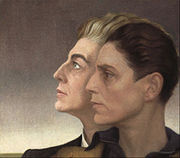.gif)
Gluck (Hannah Gluckstein)
Encyclopedia

Biography
Gluck was born into a wealthy Jewish family, the child of Joseph Gluckstein, whose brothers Isidore and Montague had founded J. Lyons and Co.J. Lyons and Co.
J. Lyons & Co. was a market-dominant British restaurant-chain, food-manufacturing, and hotel conglomerate founded in 1887 as a spin-off from the Salmon & Gluckstein tobacco company....
, a British coffee house and catering empire. Gluck's American-born mother, Francesca Halle, was an opera singer. Gluck's brother, Sir Louis Gluckstein
Louis Gluckstein
Colonel Sir Louis Halle Gluckstein, GBE, TD, KC, DL was a British lawyer and Conservative Party politician.- Career :Gluckstein was educated at St Paul's School and Lincoln College, Oxford...
, was a Conservative politician.
In the 1920s and 30s Gluck became known for portraits and floral paintings; the latter were favoured by the interior decorator Syrie Maugham. Gluck insisted on being known only as Gluck, "no prefix, suffix, or quotes", and when an art society of which Gluck was vice president identified Gluck as "Miss Gluck" on its letterhead, Gluck resigned. Gluck identified with no artistic school or movement and showed Gluck's work only in solo exhibitions, where they were displayed in a special frame Gluck invented and patented. This Gluck-frame rose from the wall in three tiers; painted or papered to match the wall on which it hung, it made the artist's paintings look like part of the architecture of the room.
One of Gluck's best-known paintings, Medallion, is a dual portrait of Gluck and Gluck's lover Nesta Obermer, inspired by a night in 1936 when they attended a Fritz Busch
Fritz Busch
Fritz Busch was a German conductor.Busch was born in Siegen, Province of Westphalia. He held posts conducting opera at Aachen, Stuttgart and Dresden. In 1933 he was dismissed from his post at Dresden because of his opposition to the new Nazi government of Germany...
production of Mozart's Don Giovanni
Don Giovanni
Don Giovanni is an opera in two acts with music by Wolfgang Amadeus Mozart and with an Italian libretto by Lorenzo Da Ponte. It was premiered by the Prague Italian opera at the Teatro di Praga on October 29, 1787...
. According to Gluck's biographer Diana Souhami, "They sat in the third row and she felt the intensity of the music fused them into one person and matched their love." Gluck referred to it as the "YouWe" picture. It was later used as the cover of a Virago Press
Virago Press
Virago is a British publishing company founded in 1973 by Carmen Callil to publish books by women writers. Both new works and reissued books by neglected authors have featured on the imprint's list....
edition of The Well of Loneliness
The Well of Loneliness
The Well of Loneliness is a 1928 lesbian novel by the British author Radclyffe Hall. It follows the life of Stephen Gordon, an Englishwoman from an upper-class family whose "sexual inversion" is apparent from an early age...
. Gluck also had a romantic relationship with the British floral designer Constance Spry
Constance Spry
Constance Spry was a famous British educator, florist and author in the mid-20th century.- Background :Constance Spry was born Constance Fletcher in Derby in 1886, eldest child and only daughter of George Fletcher and his wife Henrietta Maria Fletcher...
, whose work informed the artist's paintings.
In 1944 Gluck moved to Chantry House in Steyning
Steyning
Steyning is a small town and civil parish in the Horsham District of West Sussex, England. It is located at the north end of the River Adur gap in the South Downs, four miles north of Shoreham-by-Sea...
, Sussex, living with lover Edith Shackleton Heald until her death.
In the 1950s Gluck became dissatisfied with the artist's paints available and began a "paint war" to increase their quality. Ultimately, Gluck persuaded the British Standards Institution to create a new standard for oil paints; however, the campaign consumed Gluck's time and energy to the exclusion of painting for more than a decade.
In Gluck's seventies, using special handmade paints supplied free by a manufacturer who had taken Gluck's exacting standards as a challenge, Gluck returned to painting and had another well-received solo show. It was Gluck's first since 1937, and Gluck's last: Gluck died in 1978.
Gluck's last major work was a painting of a decomposing fish head on the beach entitled Rage, Rage against the Dying of the Light.
External links
- Hannah Gluckstein on glbtq.comGlbtq.comglbtq.com is an online encyclopedia that presents detailed biographies of notable gay, lesbian, bisexual, transgender, and queer people. It was named one of the "Best Free Reference Web Sites" in 2005 by the American Library Association....
- Paintings by Gluck at the National Portrait Gallery

